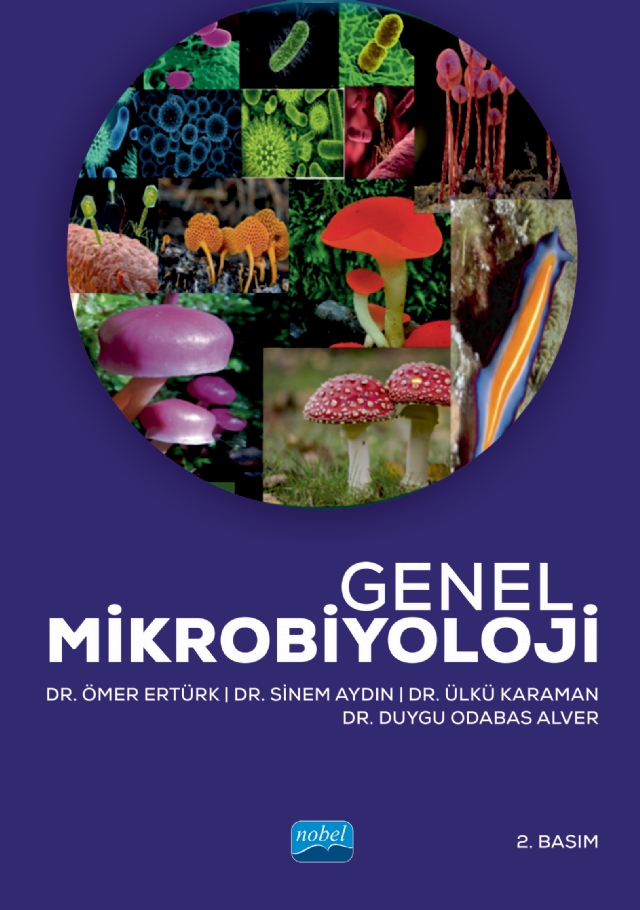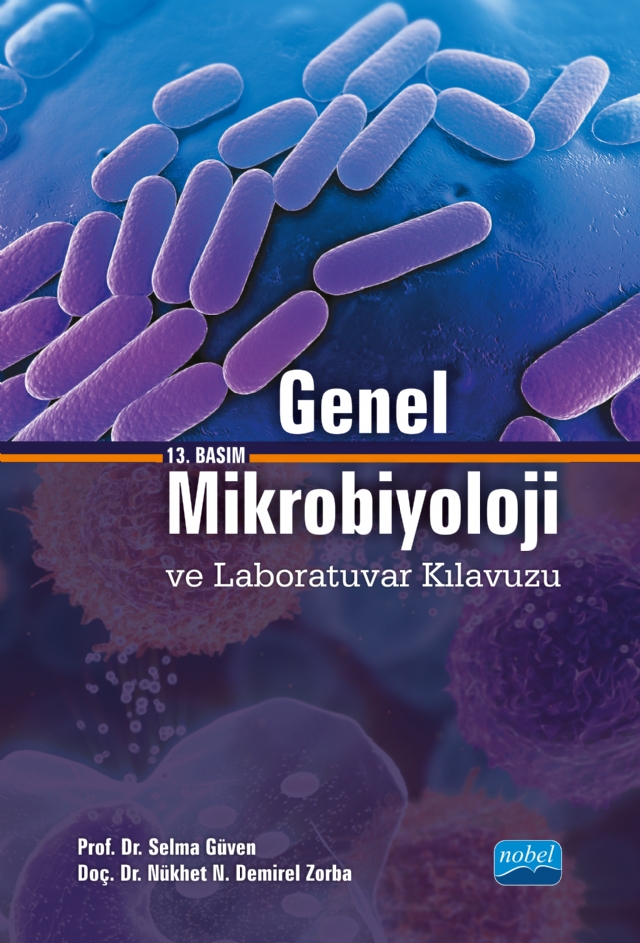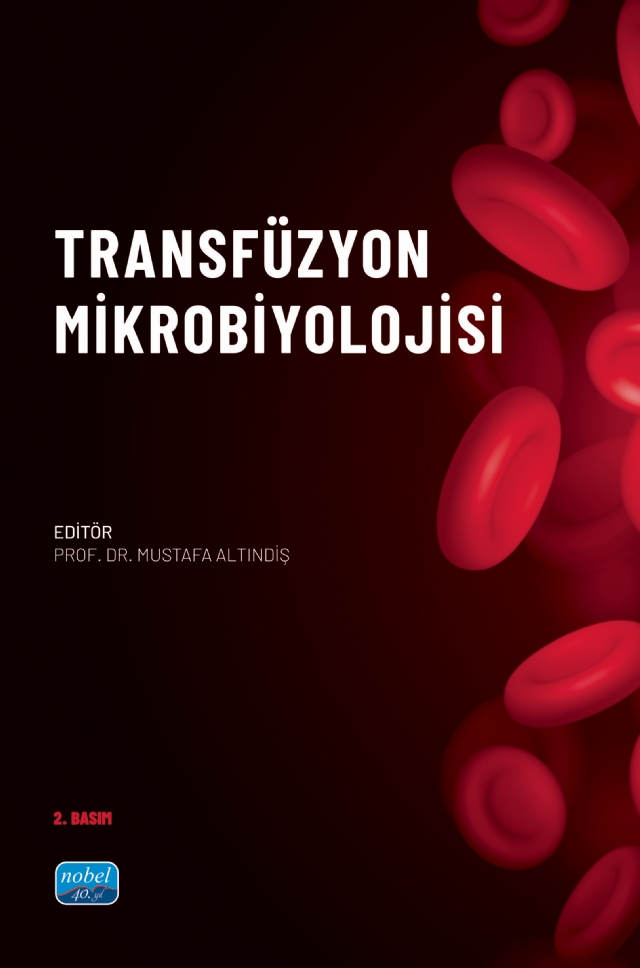Medical Microbiology \ 1-1

Microbiology has become an important and interesting field for beginners. While learning the content and concepts of basic microbiology, many questions are asked: How do I learn the names of all these microorganisms? What infection does bacteria, virus or fungus cause and which diseases do they cause? How are these diseases treated? In this book, comprehensive information is presented about the information that a student or an academician interested in the field of microbiology is curious about in the field of microbiology. The basic concepts of General and Molecular Microbiology have been tried to be presented in a clear and concise manner that will appeal to students studying in different health fields and academicians interested in microbiology. The topics are written in a plain language, with uncomplicated explanations for difficult concepts. The topics were summarized through tables and figures rather than a long text, and colorful visuals were included for students. In particular, the important points in the reviews were highlighted in the boxes to help the students, and the study questions were prepared to address the relevant aspects of each subject, including clinical cases, and each section was prepared with current developments and information on microbiology. The book starts with a general introduction to microbiology and continues with chapters where general microbiology issues are discussed in detail. All microorganisms are given individually under sections. The sections on bacteria, viruses, fungi and parasites are neatly arranged. Each chapter is presented in color to excite those interested in microbiology and engage them while teaching new information. The book will also be useful in the laboratory applications of the subjects that form the basis of microbiology in the faculties of science, education faculties, medical faculties and dentistry faculties.

The first edition of our book, of which we have made the 12th edition, was made in 2003 under the title of "General Microbiology". It includes topics such as the morphology, cell structures, development, reproduction, ecology, hereditary changes, classification of microorganisms and consists of 10 chapters. In the 2 (2007), 3 (2011), 4 (2013), 5 (February 2015), 6 (November 2015) editions of the book, tools and equipment used in the microbiology laboratory, aseptic technique, sterilization, microscope types, staining methods, pure culture techniques Laboratory applications such as , media, counting methods are also included. Thus, the book consisting of 24 chapters was named as “General Microbiology and Laboratory Guide”.
In each renewed edition, new sources on the subject were scanned and important information was added. In the 4th edition made in 2013, no significant changes were made in the subject headings except for the additional titles of the structure and functions of nucleic acids (3.2.8.1.) and general and current summary information about antibiotics (5.5.). However, in the 5th edition, the subsection on the structure-functions of nucleic acids (3.2.8.1.) was taken to the 9th section and the name of this section was changed to "genetics of microorganisms and hereditary change". In the 9th edition, additions were made to the 10th chapter. In the 10th and 11th editions, some grammatical errors were corrected and in the last edition the importance of microbiology was added.
Our aim is to present a book on General Microbiology to the students of the Food Engineering Department of the faculties of Engineering and Agriculture and to the students of other departments studying General Microbiology at Universities. Of course, we will be proud that everyone who is interested in the subject will benefit from our book.
We are happy to be able to make the tenth edition of our book, which is popularly read in the relevant departments of both our universities and vocational schools.
In each renewed edition, new sources on the subject were scanned and important information was added. In the 4th edition made in 2013, no significant changes were made in the subject headings except for the additional titles of the structure and functions of nucleic acids (3.2.8.1.) and general and current summary information about antibiotics (5.5.). However, in the 5th edition, the subsection on the structure-functions of nucleic acids (3.2.8.1.) was taken to the 9th section and the name of this section was changed to "genetics of microorganisms and hereditary change". In the 9th edition, additions were made to the 10th chapter. In the 10th and 11th editions, some grammatical errors were corrected and in the last edition the importance of microbiology was added.
Our aim is to present a book on General Microbiology to the students of the Food Engineering Department of the faculties of Engineering and Agriculture and to the students of other departments studying General Microbiology at Universities. Of course, we will be proud that everyone who is interested in the subject will benefit from our book.
We are happy to be able to make the tenth edition of our book, which is popularly read in the relevant departments of both our universities and vocational schools.

In this book, which aims to bring together the secrets of healthy life and related researches of the future in a comprehensive and encyclopedic way, almost all the issues related to the microbiota in the clinic are mentioned. In addition, information on probiotics and the use of probiotics in clinical spectra is presented in their latest updated versions, while different application areas of probiotics and rational nutrition are listed one after the other.
Although the effects of microbiota and probiotics on health and diseases are known, there are still many questions to be answered. Although studies on microbiota have been started in Turkey, infrastructure and standardization problems have not been resolved and there is a need for regulation in many aspects. Because this area has a strategic importance for our country. Although it is changing rapidly, our eating habits are still different from Western countries. Therefore, it is likely that we have a unique intestinal bacterial structure of our own. With the studies to be done on this subject, special diagnosis and treatment methods can be developed for us. The Microbiota, Probiotics and Rational Nutrition book, in which the latest information, experiences and the point reached are discussed by teachers working in different fields of expertise, will also be instrumental in sharing and planning on what can be done in Turkey, who will take part in what way, and how to work.
With the hope and hope that it will be useful to all its readers...
Although the effects of microbiota and probiotics on health and diseases are known, there are still many questions to be answered. Although studies on microbiota have been started in Turkey, infrastructure and standardization problems have not been resolved and there is a need for regulation in many aspects. Because this area has a strategic importance for our country. Although it is changing rapidly, our eating habits are still different from Western countries. Therefore, it is likely that we have a unique intestinal bacterial structure of our own. With the studies to be done on this subject, special diagnosis and treatment methods can be developed for us. The Microbiota, Probiotics and Rational Nutrition book, in which the latest information, experiences and the point reached are discussed by teachers working in different fields of expertise, will also be instrumental in sharing and planning on what can be done in Turkey, who will take part in what way, and how to work.
With the hope and hope that it will be useful to all its readers...

In recent years, our knowledge has increased within the scope of research on the molecular basis of diseases. With the use of increasing knowledge in both medical biology and medical genetics, diseases caused by cellular and chromosomal changes, which have a genetic basis, are tried to be understood on the one hand and treated on the other. Written from this point of view, this book covers all topics from the beginning of life to cell death mechanisms under the main title of "Medical Biology". Under the main title of “Genetics”, it provides an integrity starting from the structure of DNA and RNA, including the features of the genetic code, mutations and inheritance patterns. The difference of our book from its counterparts written so far is that the second part includes molecular genetics applications and practical applications step by step. There are six chapters in the "Application" part of the book, in which medical biology and genetics are covered in fourteen chapters. This book, which has been prepared in accordance with the curriculum of the relevant boards of medical faculties, is a textbook that can be used in the relevant departments of health sciences faculties, dentistry faculties and health schools. This book, which has been prepared as a result of intense effort by following up-to-date data in a period of about two years, is a resource that undergraduate, graduate students and all academics can benefit from.

Medical (clinical) laboratory management has a key position in the healthcare sector in terms of human health, patient safety, quality of community/population life and cost effective healthcare expenditures. Medical/Clinical laboratories (MLs/CLs) are also the data centers of healthcare institutions. Laboratory tests are requested from approximately 80% of individuals admitted to a health institution, and 70-80% of medical decisions are made based on the test results. In addition to providing reliable test results to each individual/patient in a timely and cost-effective manner, information about public health status can also be obtained from laboratory data.
Their success in these responsibilities and duties is directly proportional to their ability to
establish a well-structured risk, quality and process-based system.
In this book: a risk, quality and process-based management model is presented. The book covers the steps of recognizing and introducing the process framework of a medical (clinical) laboratory that is composed of the management and support processes. The total examination process, which is the main core process of an ML/CL, is composed of 5 subprocesses. The steps also include the application of risk and quality management to every process. By following this book, the laboratory professional will be able to define and introduce all the processes of a ML/CL and establish the management system with the process approach. Laboratory professionals will be able to familiarize themselves with each process and create process-oriented risk and quality management systems following the recommended steps. A continuous process improvement system, based on the Plan-Do-Check-Act (PDCA) Cycle, will also be established. Hence, the ML/CL will be prepared to meet all the requirements of external assessment programs, including the ISO 9001:2015 Quality Management System Standard, the excellence models such as the EFQM, and the Accreditation Standard ISO 15189:2022 for Medical Laboratories-Requirements for Quality and Competence.". The book is designed to be used as a handbook and consists of 22 chapters. The reader will be able to define the process framework of a medical laboratory and identify its documents according to the document hierarchy. Additionally, they can structure the total testing process, which includes preanalytical, analytical, and postanalytical processes both inside and outside the laboratory. Furthermore, the book covers topics on management and support processes as well as data analysis, the development of training programs for laboratory professionals and providing the useful information to the patients. Moreover, the book reviews the governance system, the
alignment of process objectives with strategic goals, outcomes of performed projects related to the medical laboratory management, and the essential competencies for a medical laboratory manager.
This book should be read with the book “Process-Based Management Are You Ready for Digital Transformation? (For Public, Private and Non-Governmental Organizations) by Diler Aslan”
Their success in these responsibilities and duties is directly proportional to their ability to
establish a well-structured risk, quality and process-based system.
In this book: a risk, quality and process-based management model is presented. The book covers the steps of recognizing and introducing the process framework of a medical (clinical) laboratory that is composed of the management and support processes. The total examination process, which is the main core process of an ML/CL, is composed of 5 subprocesses. The steps also include the application of risk and quality management to every process. By following this book, the laboratory professional will be able to define and introduce all the processes of a ML/CL and establish the management system with the process approach. Laboratory professionals will be able to familiarize themselves with each process and create process-oriented risk and quality management systems following the recommended steps. A continuous process improvement system, based on the Plan-Do-Check-Act (PDCA) Cycle, will also be established. Hence, the ML/CL will be prepared to meet all the requirements of external assessment programs, including the ISO 9001:2015 Quality Management System Standard, the excellence models such as the EFQM, and the Accreditation Standard ISO 15189:2022 for Medical Laboratories-Requirements for Quality and Competence.". The book is designed to be used as a handbook and consists of 22 chapters. The reader will be able to define the process framework of a medical laboratory and identify its documents according to the document hierarchy. Additionally, they can structure the total testing process, which includes preanalytical, analytical, and postanalytical processes both inside and outside the laboratory. Furthermore, the book covers topics on management and support processes as well as data analysis, the development of training programs for laboratory professionals and providing the useful information to the patients. Moreover, the book reviews the governance system, the
alignment of process objectives with strategic goals, outcomes of performed projects related to the medical laboratory management, and the essential competencies for a medical laboratory manager.
This book should be read with the book “Process-Based Management Are You Ready for Digital Transformation? (For Public, Private and Non-Governmental Organizations) by Diler Aslan”

The fact that the epidemic that occurred anywhere in the globalizing world was on the agenda of other countries in a short time has made medical microbiology more important as well as many disciplines. In this sense, microbiology education with its theoretical and practical applications has become even more important and necessary in training professional technical personnel for the field. The book is planned as a laboratory guide that provides up-to-date practical information without going into any detail to Health Services Vocational Schools Medical Laboratory Technician students and educators, medical school students, medical microbiology graduate-doctorate and medical specialty students, and moreover, to everyone related to medical microbiology.

The field of transfusion microbiology is of particular importance since the use of blood, which is still the only source of human blood, as a life-saving medical product when necessary, concerns all parties and processes in terms of patient safety.
Microbiology has always been intertwined with transfusion medicine from the very beginning. With our current knowledge, viral hepatitis and later HIV have been observed as inevitable and persistent complications of transfusions long after the onset and development of transfusion. For more than four decades, blood centers have struggled with the control of these and other transfusion-transmitted microorganisms. In the years before the routine screening of hepatitis (especially hepatitis C), blood transfusions were accepted as the main mode of transmission of these agents. Subsequent HIV transmission could also be a major transfusion tragedy.
All these have taught us that the process must be managed with serious actions in ensuring blood transfusion safety. Today, even more unpredictable factors have emerged, and it seems that they will continue to emerge and besiege humanity.
Microbiology has always been intertwined with transfusion medicine from the very beginning. With our current knowledge, viral hepatitis and later HIV have been observed as inevitable and persistent complications of transfusions long after the onset and development of transfusion. For more than four decades, blood centers have struggled with the control of these and other transfusion-transmitted microorganisms. In the years before the routine screening of hepatitis (especially hepatitis C), blood transfusions were accepted as the main mode of transmission of these agents. Subsequent HIV transmission could also be a major transfusion tragedy.
All these have taught us that the process must be managed with serious actions in ensuring blood transfusion safety. Today, even more unpredictable factors have emerged, and it seems that they will continue to emerge and besiege humanity.